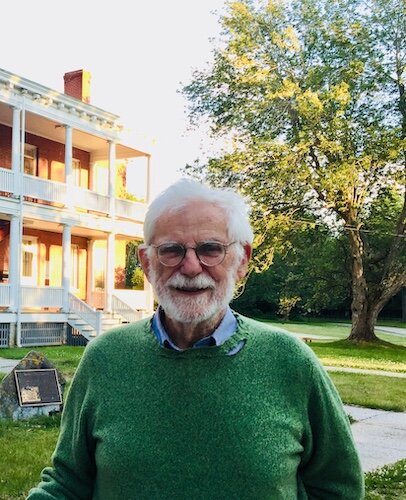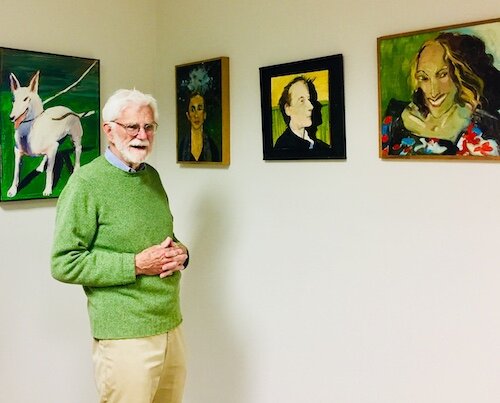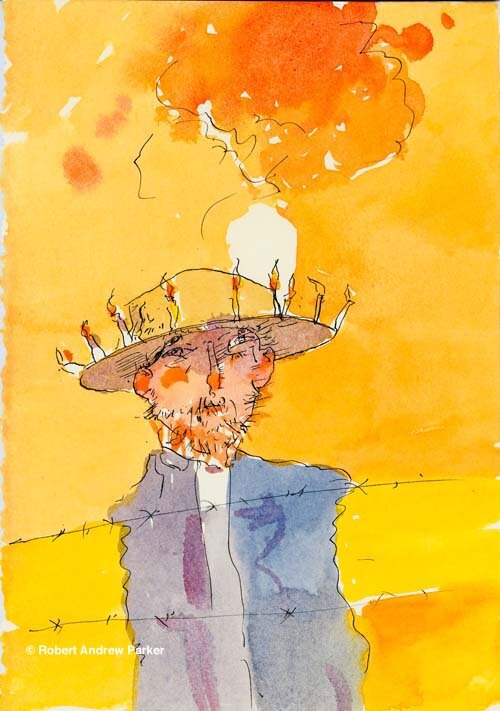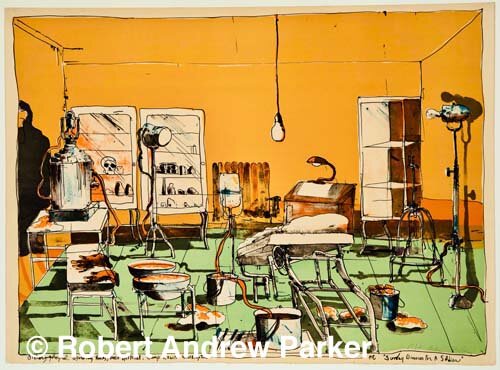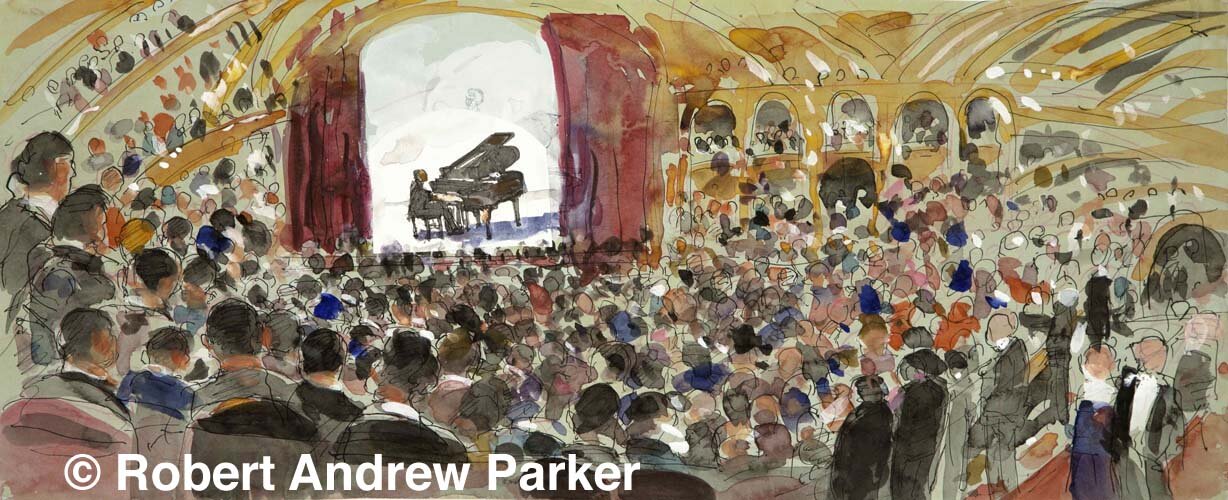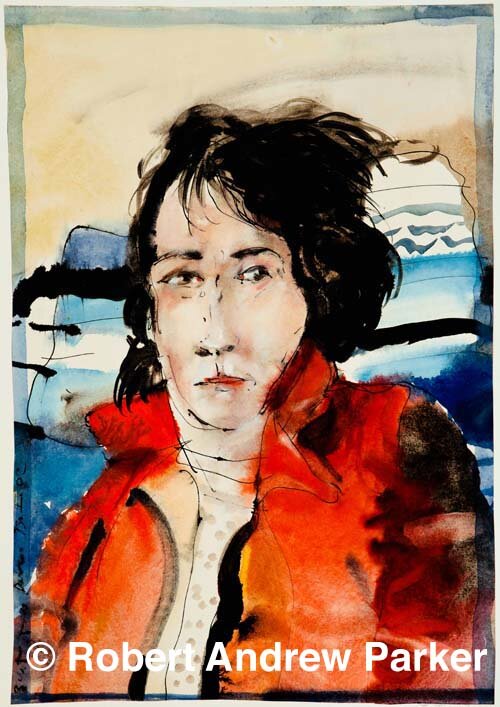ABOUT ROBERT ANDREW PARKER
Parker was born May 14, 1927 in Norfolk, Virginia to William and Harriet (Cowdin) Parker. William Parker was a dentist with the U.S. Public Health Service. Harriet Parker was an amateur watercolorist who ensured her son had access to art supplies. Jazz music was a big part of Parker’s childhood thanks to his father's extensive record collection and appreciation for jazz. Before he was ten years old, Parker was diagnosed with tuberculosis. William Parker requested a transfer to Fort Stanton, New Mexico where there was a well-staffed, federal clinic and sanitarium to care for patients with TB. The dry climate, fresh air, well-ventilated rooms and the great outdoors in New Mexico mountain country were believed to be beneficial for TB patients at the time.
Photograph by Rachel Walls.
For two years, Robert Andrew Parker lived outside in bed on a screened-in porch overlooking the hills. Parker was alone most of the day, so he read and drew a lot. Robert Andrew Parker reflects, “I always felt that in some way, with all that free time for reading and drawing, the illness turned out to be a blessing. It was painless. All you had to do was stay down, rest and be quiet. Eventually, I got well. ”
Those countless hours of reading in bed-ridden solitude, Robert Andrew Parker believes, helped form his love for literature that years later heightened his artistic sensitivity as he became a much sought-after illustrator for books by such literary heavyweights as W.H. Auden, William Faulkner, Vladimir Nabokov, Stendahl and Marianne Moore.
Robert Andrew Parker attended and instructed at the Skowhegan School of Painting and Sculpture in Maine. Photo of the school’s campus in 1974 by Thomas Crotty. Photograph courtesy of the Estate of Thomas Crotty.
Robert Andrew Parker graduated from the Art Institute of Chicago in 1952 after serving in the Army in the 1940s. He moved to New York after he spent a summer at the Skowhegan School of Painting and Sculpture studying under Jack Levine. Parker continued to develop his printmaking skills at Atelier 17, an historically important printmaking studio founded by the renowned English painter and printmaker, Stanley William Hayter. Robert Andrew Parker was also chosen in 1952 as the youngest artist to show at the Metropolitan Museum of Art in the — Exhibition of American Watercolors, Drawings and Prints — the exhibition featured Stuart Davis, John Marin, Robert Andrew Parker and Jackson Pollock.
ROBERT ANDREW PARKER. Vincent Van Gogh. Circa 1980s. Watercolor.
Primarily known for his painting and prints of figures, landscapes and animals, Robert Andrew Parker also produced set designs for operas and films. Early in his career, Parker was hired to travel to France and paint reproductions of Van Gogh's paintings which were used as backdrop props in Lust for Life — the 1956 MGM Technicolor classic film directed by Vincente Minnelli about artist Vincent Van Gogh. Kirk Douglas won the Golden Globe Award for Best Actor in a Motion Picture Drama and Anthony Quinn won an Academy Award for Best Supporting Actor.
ROBERT ANDREW PARKER. Sunday Dinner for a Soldier. Circa 1970s. Lithograph. In the permanent collections of both the Museum of Modern Art in New York and the Portland Museum of Art in Maine.
Robert Andrew Parker has made a living selling his art and teaching classes at the Skowhegan School of Painting and Sculpture, Rhode Island School of Design, Gerrit Rietveld Academie in Amsterdam, Parsons School of Design, Pratt Institute and the School of Visual Arts in New York. The National Institute of Arts and Letters recognized Robert Andrew Parker in 1962 for “his witty, delicate and astringent content and for the rightness of its pictorial presentation.”
Hand-colored drawings from letters A to Z by ROBERT ANDREW PARKER. Photograph by Ross Bertran.
Parker has produced countless bound and portfolio-style books: alphabets, journals of dreams and travels, portraits of women writers, all collected in folios of various shapes, sizes, and mediums. Robert Andrew Parker has illustrated numerous literary classics by authors from Franz Kafka to Joseph Heller; and for the United States Air Force in Rwanda and Panama; album covers for Columbia Records; for The New Yorker, Fortune, Sports Illustrated, Playboy and Time magazines; and one hundred (100) children’s books receiving the Randolph Caldecott Medal and the Robert F. Siebert Informational Book Medal.
ROBERT ANDREW PARKER exhibited with Jackson Pollack in 1952 at the Metropolitan Museum of Art and recently illustrated award winning Action Jackson — a biography of Pollack that won the Robert F. Siebert Informational Book Medal.
Robert Andrew Parker is a drummer in addition to visual artist. His band — Jive by Five — plays a hard-swinging recreation of the great jump band style of the 1940s that moved out of Harlem and Chicago’s south side to become part of mainstream jazz — the music of Duke Ellington, Count Basie, Charlie Parker, Thelonious Monk and more. According to James Lincoln Collier, author of Louis Armstrong: An American Genius; Duke Ellington; Jazz: The American Theme Song and Benny Goodman and the Swing Era — all published by Oxford University Press, “They're one of the most exciting bands I've heard.”
ROBERT ANDREW PARKER. Jackson Pollack painting in his studio in Springs, East Hampton, NY as seen in Action Jackson — a children’s book about Jackson Pollack — written by Jan Greenberg and Sandra Jordan, illustrated by Robert Andrew Parker.
Art and jazz have been two long-running passions in the life of Robert Andrew Parker. He received a Schneider Family Book Award — an award given by the American Library Association for excellence in portraying the disability experience in literature for youth —for The Piano Starts Here: Young Art Tatum, which Robert Andrew Parker wrote and illustrated in 2008. Art Tatum was nearly blind, but his passion for the piano and sound memory drove him to become a virtuoso who was revered by both classical and jazz pianists.
Robert Andrew Parker says in The Piano Starts Here: Young Art Tatum, “In 1946 (while in the Army’s B-29 bomber training program) I went to 52nd Street in New York City, where most of the jazz greats played — and I heard Lester Young, Ben Webster, Roy Eldridge, Beryl Booker, and Art Tatum. The place was jammed, and Tatum was amazing.”
Robert Andrew Parker wrote and illustrated Piano Starts Here: A Young Art Tatum in 2008. Parker received a Schneider Family Book Award — an award given by the American Library Association for excellence in portraying the disability experience in literature for youth.
Robert Andrew Parker and patrons at Rachel Walls Fine Art for the opening of his exhibition. Photograph by Rachel Walls.
In October 2019, all the Parkers gathered with their respective bands for a giant Parker Family Music Performance in New York. In this photo, Eric and Chris Parker on drums and Tony Levin – one of the most recognizable bass players in Rock Music – in front of an image by Pierce Kearney of Nicholas, Robert Andrew Parker, Tony, Geoff and Eric in West Cornwall, CT. Photograph by Rachel Walls.
ROBERT ANDREW PARKER. Endpapers for Piano Starts Here: A Young Art Tatum. 2008. Watercolor.
Robert Andrew Parker is in the permanent collections of the Art Institute of Chicago, Los Angeles County Museum of Art, Metropolitan Museum of Art, Museum of Modern Art, Smithsonian American Art Museum and the Whitney Museum of American Art. Between 1953 and 1978, Parker was included in twelve (12) exhibitions at the Museum of Modern Art.
Parker's love for music and drumming has been passed on to four of his five sons — all serious, accomplished drummers — who have formed a much respected, family drum dynasty. Parker's oldest son — Chris Parker — has backed James Brown, Ray Charles, Bob Dylan, Paul Butterfield, The Brecker Brothers, Cher, Natalie Cole, Aretha Franklin, Gladys Knight and the Pips, Patti LaBelle, Will Lee, Peaches and Herb, Peter, Paul & Mary, Barry Manilow, Bette Midler, Esther Phillips, Rod Stewart and Luther Vandross. Chris was a member of the Saturday Night Live house band for six years. Eric Parker has toured internationally with Joe Cocker and performed with Bonnie Raitt, Steve Winwood and Ian Hunter. Tony Parker - who currently performs with Woodstock, NY funk band Cloudburst - has backed Rick Danko, Joan Osborne, John Pacheco, John Prine, Laura Nyro and Mary Travers of Peter, Paul & Mary. Parker's youngest son — Nicholas Parker — has performed with Black 47, Rick Derringer, Robbie Dupree, Todd Rundgren and Orleans. Chris, Eric, Tony and Nicholas Parker have all played with their father. The only non-drumming son — Geoffrey Parker — plays guitar and is a visual artist.
ROBERT ANDREW PARKER. Judy. 2002. Watercolor. Portrait of Judith Mellecker, Parker’s wife — a writer and former editor for The New Yorker magazine.
Robert Andrew Parker lives in West Cornwall, Connecticut with his wife, Judith Mellecker — a writer and editor who contributed for many years to "Talk of the Town" for The New Yorker magazine. Judith Mellecker wrote and Robert Andrew Parker illustrated The Fox and the Kingfisher (Knopf, 1990) and Randolph's Dream (Knopf, 1991) together.

